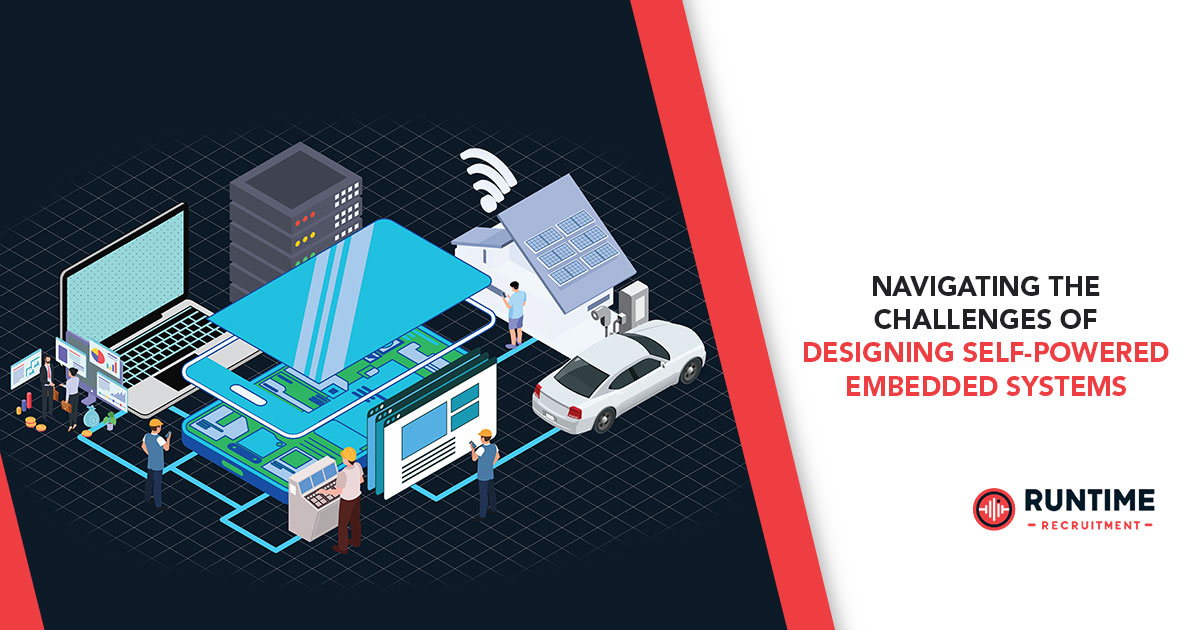Embedded systems are the unsung heroes of our modern world, quietly powering everything from smart wearables and medical implants to industrial sensors and environmental monitors. As the demand for ubiquitous, long-lasting, and truly “set-and-forget” devices skyrockets, the allure of self-powered embedded systems becomes increasingly irresistible. Imagine a sensor network in a remote agricultural field, silently collecting data for years without a single battery change, or a medical device continuously monitoring vitals without requiring external power. This vision, while compelling, presents a formidable array of challenges for embedded engineers.
Designing systems that generate their own power from ambient sources isn’t merely about slapping on a solar panel or a tiny turbine. It’s a fundamental paradigm shift that demands a holistic approach to every aspect of the system, from component selection and circuit design to software architecture and deployment strategy. In this in-depth exploration, we’ll delve into the multifaceted challenges faced by embedded engineers striving to bring self-powered systems to life.
The Elusive Energy Source: Harvesting the Ambient World
The cornerstone of any self-powered system is its ability to harvest energy from its environment. While promising, ambient energy sources are inherently unpredictable, low-power, and often intermittent. This forms the first, and perhaps most significant, hurdle.
Variability and Low Power Density: Unlike a conventional power supply, ambient energy sources like solar, thermal, vibration, and RF are rarely consistent. Solar irradiance varies with time of day, weather, and season. Vibrations can be sporadic and of varying frequencies. Thermal gradients may fluctuate. This variability means that the harvested power is often insufficient to continuously power the embedded system at its peak operational demands. Engineers must design systems that can function effectively with highly dynamic and often minuscule power inputs.
This necessitates:
- Careful Characterization: Thoroughly understanding the power profile of the chosen energy source in the target environment is paramount. This involves detailed measurements and analysis to determine average power, peak power, and periods of low or no energy availability.
- Source Selection and Optimization: Choosing the right energy harvesting transducer is critical. Photovoltaic cells offer good power density in well-lit environments, while piezoelectric materials excel at converting mechanical vibrations. Thermoelectric generators capitalize on temperature differences. Each has its own characteristics, efficiency curves, and optimal operating conditions. The challenge lies in selecting the most suitable transducer and optimizing its integration to maximize energy capture.
Conversion Inefficiencies: The process of converting ambient energy into usable electrical energy is never 100% efficient. Each stage of the energy harvesting chain – from the transducer itself to the power management unit – introduces losses.
- Transducer Efficiency: The efficiency of solar cells (typically 15-20%), piezoelectric elements, or thermoelectric generators dictates how much of the available ambient energy can be captured. Improving this efficiency is an ongoing area of research.
- Power Management Unit (PMU) Losses: Once harvested, the raw, often unregulated power needs to be converted into stable voltages suitable for the embedded system’s components. This is where Power Management Integrated Circuits (PMICs) play a crucial role. However, even the most advanced PMICs introduce quiescent currents and conversion losses. Engineers must select PMICs with ultra-low quiescent current and high conversion efficiency across a wide range of input voltages and load conditions, especially at very low power levels where efficiency typically drops. Maximum Power Point Tracking (MPPT) algorithms are often employed in PMICs to extract the maximum possible power from the energy harvester, especially for solar and certain thermal sources.
The Power Budget tightrope: Micro-Joules and Milliseconds
Even with optimized energy harvesting, the total available energy in a self-powered system is typically orders of magnitude lower than in traditional battery-powered or wired systems. This necessitates an extreme focus on ultra-low power design at every layer.
Component Selection and Power Profiling: Every single component in a self-powered system becomes a critical point for power consumption.
- Ultra-Low Power Microcontrollers (MCUs): Choosing an MCU with various low-power modes (sleep, deep sleep, hibernate) and fast wake-up times is fundamental. The ability to dynamically scale clock frequencies and core voltages (Dynamic Voltage and Frequency Scaling – DVFS) based on computational load is also crucial.
- Energy-Efficient Peripherals and Sensors: Sensors, communication modules (BLE, LoRa, Zigbee), and memory components must be selected for their minimal active and quiescent current consumption. Even seemingly small details, like the leakage current of GPIO pins or the resistance of pull-up/pull-down resistors, can significantly impact the overall power budget.
- Detailed Power Budgeting: Engineers must create a meticulous power budget, estimating the current draw of each component in every operating state (active, idle, sleep). This involves understanding datasheet specifications for active current, sleep current, wake-up times, and supply voltage ranges. This budget then needs to be compared against the anticipated harvested power to determine system feasibility and operational lifetime.
Software Optimization for Energy Efficiency: Hardware choices are only half the battle; software plays an equally critical role in minimizing energy consumption.
- Event-Driven Architecture: Moving away from continuous polling and towards an event-driven architecture, where the system wakes up only when absolutely necessary (e.g., on a sensor interrupt or a timer event), is paramount.
- Aggressive Sleep Management: The system should spend the vast majority of its time in the deepest possible sleep state. This means carefully structuring code to perform tasks quickly and then immediately re-enter sleep mode. Minimizing wake-up latency and the energy cost of transitions between power states is key.
- Optimized Algorithms and Data Structures: Efficient algorithms that minimize computational cycles and data transfers directly translate to lower power consumption. Choosing appropriate data structures can reduce memory accesses, another power-hungry operation.
- Minimizing Wireless Communication: Wireless communication, especially radio transmission, is often the most power-intensive activity. Strategies like data compression, infrequent transmission, and wake-on-radio mechanisms are vital to reduce this energy drain.
Energy Storage and Intermittency: Bridging the Gaps
Ambient energy is not constant. Periods of high energy availability are often followed by periods of scarcity (e.g., night for solar-powered systems). This necessitates robust energy storage and sophisticated power management to ensure continuous operation.
Energy Storage Technologies: Traditional batteries, while offering high energy density, have limitations in self-powered systems due to their finite lifespan, temperature sensitivity, and often large form factor.
- Capacitors and Supercapacitors: These offer high power density, fast charging/discharging cycles, and a virtually unlimited number of cycles, making them ideal for buffering intermittent energy bursts and providing peak power. However, their energy density is lower than batteries, meaning they can only store energy for short periods.
- Rechargeable Batteries (Li-Ion, Li-Po, Thin-Film): For applications requiring longer periods of operation without ambient energy, small, low-power rechargeable batteries can be integrated. However, their charging and discharging cycles must be carefully managed to maximize their lifespan, especially when dealing with the variable charging profiles from energy harvesters.
- Hybrid Storage Solutions: Often, the optimal solution involves a hybrid approach, combining a supercapacitor for short-term buffering and peak power delivery with a small rechargeable battery for longer-term energy storage.
Intermittent Computing and Power-Fail Robustness: When harvested energy is insufficient, the system may enter a power-down state. For continuous data logging or critical applications, this intermittency poses a significant challenge.
- Non-Volatile Memory: Data integrity is paramount. Designers must ensure that critical data is saved to non-volatile memory (e.g., FRAM, MRAM, or low-power Flash with careful wear-leveling) before a power-down event.
- Context Preservation: When the system resumes operation after a power-down, it needs to know where it left off. Implementing mechanisms to save and restore the system’s state (register values, program counter, task context) is crucial for seamless operation. This often involves specialized hardware support within the MCU or careful software design to manage state transitions.
- Power-Aware Task Scheduling: Operating systems and application logic must be “power-aware,” meaning they prioritize critical tasks, complete them quickly, and checkpoint progress frequently to minimize data loss during unexpected power loss.
The Integration Imperative: Form Factor, Cost, and Reliability
Beyond the core power challenges, practical considerations for self-powered systems add further layers of complexity.
Form Factor and Packaging: Self-powered systems are often intended for compact, remote, or wearable applications. Integrating energy harvesting transducers, storage elements, and the embedded electronics into a small, robust form factor can be extremely challenging.
- Miniaturization: Components must be as small as possible without compromising performance or energy efficiency.
- Thermal Management: Even low-power systems can generate localized heat, which needs to be dissipated, especially in sealed or compact enclosures.
- Environmental Robustness: Many self-powered systems operate in harsh environments (extreme temperatures, humidity, vibration). Packaging must protect the sensitive electronics and ensure reliable operation over long periods.
Cost-Benefit Analysis: While eliminating battery replacement offers long-term savings, the initial cost of energy harvesting components and ultra-low power electronics can be higher. Engineers must perform a thorough cost-benefit analysis, considering the total cost of ownership, maintenance, and the specific application’s requirements.
Test and Validation: Debugging and validating the power performance of self-powered systems is exceptionally difficult.
- Measuring Micro-Amps: Accurately measuring current consumption in the micro-ampere and nano-ampere range across different operating modes requires specialized equipment and techniques.
- Simulating Environmental Conditions: Replicating the variability of ambient energy sources in a lab environment for thorough testing is complex. Accelerated life testing becomes crucial but still presents its own challenges.
- Long-Term Reliability: Ensuring the long-term reliability of energy harvesting transducers, storage elements, and ultra-low power components over years of continuous operation without intervention is a major design consideration.
The Path Forward: Innovation and Collaboration
Despite these challenges, the trajectory of self-powered embedded systems is undeniably upward. Advancements in materials science, semiconductor technology, and power management ICs are continuously pushing the boundaries of what’s possible. From more efficient thermoelectric generators to PMICs that can start up from incredibly low voltages, the tools available to embedded engineers are becoming more sophisticated.
The key to overcoming these challenges lies in a multi-disciplinary approach, combining expertise in hardware design, firmware development, power electronics, and materials science. It also demands a deep understanding of the target application’s unique energy profile and operational requirements.
Ready to power up your career?
Connect with RunTime Recruitment today. We specialize in connecting top-tier embedded engineers with cutting-edge opportunities in companies that are shaping the future of self-powered technologies.
Visit our website or reach out to our team to explore how your skills can drive innovation in this exciting domain.









